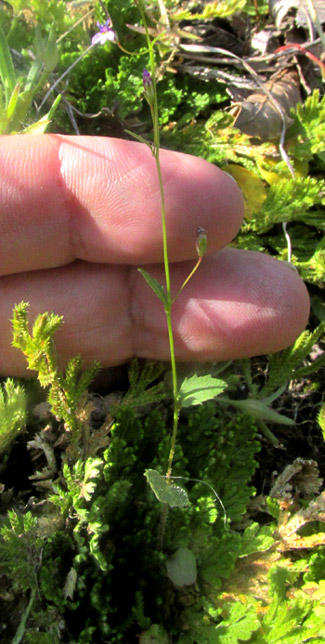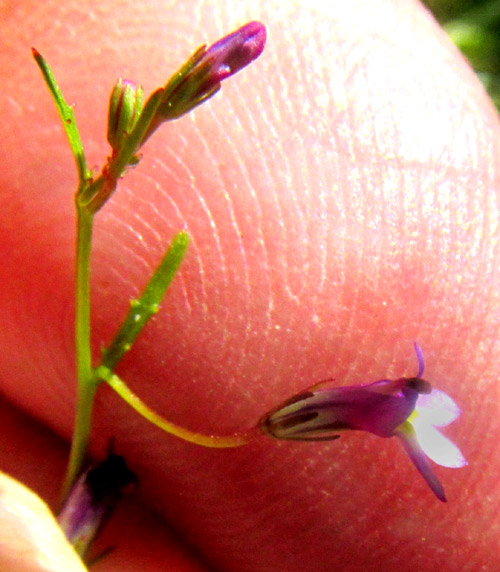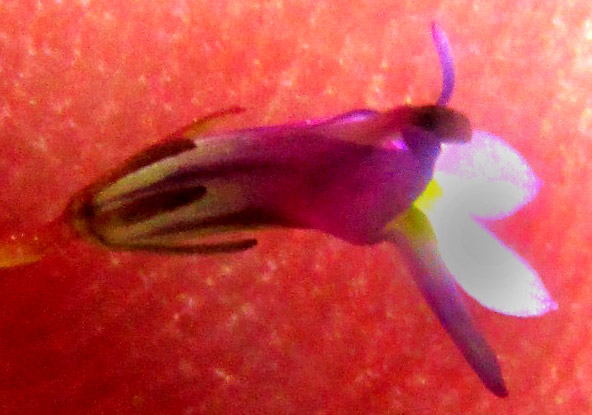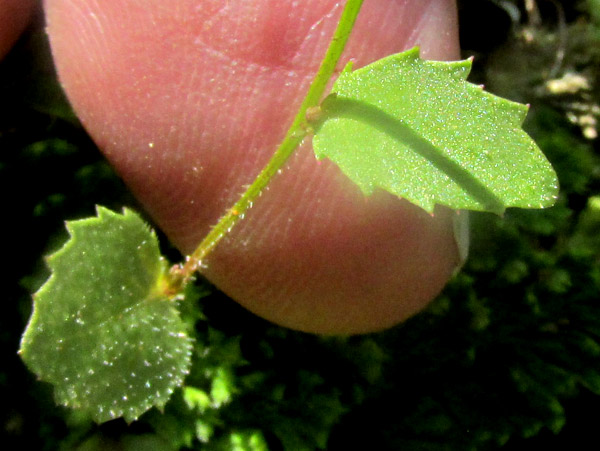Excerpts from Jim Conrad's
Naturalist Newsletter
Entry dated November 7, 2023, from notes taken at Cascadas de La Piedad waterfall 3kms NW of the community of San Pablo, municipality of Almeaco de Bonfil; bedrock of igneous andesite; N20.1003°, W100.0026°, elevation 2360 meters (7750ft); extreme southern Querétaro state, MÉXICO
LOBELIA VOLCANICA
 On a steep slope of a narrow, moist, usually shaded, erosional gully about 300m northeast of the Cascada de La Piedad, or Piety Waterfall, the above tiny wildflower arose amid a colony of spikemoss, Selaginella, as seen at the right.
On a steep slope of a narrow, moist, usually shaded, erosional gully about 300m northeast of the Cascada de La Piedad, or Piety Waterfall, the above tiny wildflower arose amid a colony of spikemoss, Selaginella, as seen at the right.

The flower shown at the left was the only one open, and it was about 5mm long (3/16 inch) long. The flower arises from a curving pedicel longer than itself.

Not only does the corolla display a definite lower lip consisting of three lobes, and an upper lip of two lobes, but also the corolla tube bends somewhat to one side. Above, note that a clublike structure with a dark head bends upward, passing through a slit in the corolla tube. The clublike structure consists of five stamens fused along their sides, forming a cylinder around the stigma-bearing style. In the above picture the corolla's slit appears to be a closed one, but it's continuous, each side of the slit curving upward to form one of the two top lobes.  That's easier seen in the corolla's frontal view shown at the right.
That's easier seen in the corolla's frontal view shown at the right.
Those familiar with wildflowers and common garden flowers will recognize the above floral features -- except for the smallness -- as exemplary of the lobelias, of the genus Lobelia of the Bellflower Family, the Campanulaceae. Currently Kew's Plants of the World Online database recognizes 441 accepted Lobelia species occurring worldwide, mostly in warmer regions. The 1997 Flora del Bajío, which includes plants of Querétaro state, recognizes about 15 species occurring in our area. Useful for determining which of those species we have is the leaves' small size, oval shape and a few prominent teeth on each margin:

In our part of highland central Mexico, if you have a Lobelia whose blue flowers arise from the axils of bracts much smaller than the leaves, the corolla tube does NOT have a slit in its side in addition to the one on top, the tube is less than 7mm long, and bends to the side like ours, it's LOBELIA VOLCANICA, with no English name, though one wants to call it the Volcano Lobelia. You might enjoy comparing our plant with a more typical, larger species also occurring at this location, Lobelia divaricata.
A special feature of Lobelia volcanica, not appearing in our pictures, is that its lower corolla tube enlarges on one side into a conical bulge 1-2mm long, referred to as a spur. Nectar-containing spurs appear to have arisen and evolved in certain Lobelia species independently from other genera not closely related, such as the larkspurs of the Buttercup Family.
Lobelia volcanica is endemic just to a fairly small part of highland central Mexico, plus there's a 1985 collection from Sinaloa state in northwestern Mexico. Wherever it occurs it's rare; the Flora del Bajío reports that already in 1997 it was threatened with extinction in our area, and much forest destruction has occurred since then. Its habitat is described as montane temperate forests of oak and pine -- ours being in the oak zone.
No human uses of Lobelia volcanica are reported, surely because of its rarity and smallness. Generally, Lobelia species are regarded both as potentially poisonous, as well as potentially useful in traditional medicine, because several species contain powerful alkaloids, especially lobeline. The lobeline molecule is so similar in structure to that of nicotine that it produces several of the same effects as nicotine. I didn't taste the leaves to see if they tasted like nicotine, which lobeline-bearing leaves do, because our little plant needed all of its few leaves.
This is a good find. At this writing, on the Internet I encounter no picture of a living Lobelia volcanica, though several dried herbarium specimens are available.